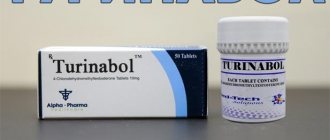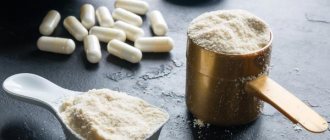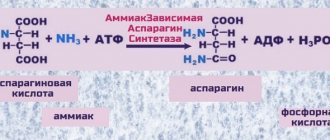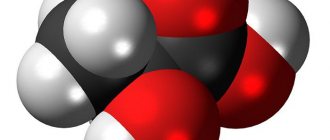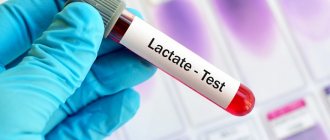© designer491 — stock.adobe.com
Share:
Glutamic (glutamic) acid is one of the types of amino acids, which is the main component of almost all proteins in the body. It belongs to the class of “stimulating” amino acids, i.e. facilitating the transmission of nerve impulses from the central to the peripheral nervous system. In the body, its concentration is 25% of the total number of these substances.
Amino acid action
Glutamic acid is valued because it takes part in the synthesis of many microelements beneficial to health (histamine, serotonin, folic acid). Due to its detoxifying properties, this amino acid helps neutralize the effects of ammonia and remove it from the body. Due to the fact that it is an integral part of proteins and is involved in energy metabolism, acid is very important for people who intensively engage in sports.
The main function of glutamic acid is to accelerate the transmission of nerve impulses due to its exciting effect on neurons. In sufficient quantities, it improves brain function, accelerating the speed of thought processes. But with its excessive concentration, nerve cells experience excessive excitation, which can lead to their damage and death. Neuroglia act in defense of neurons - they have the ability to absorb glutamic acid molecules without letting it into the intercellular space. In order to avoid an overdose, it is necessary to control the dosage and not exceed it.
Glutamic acid improves the passage of potassium into muscle fiber cells, including cardiac muscle fibers, affecting its performance. It activates the regenerative ability of microelements and prevents the occurrence of hypoxia.
The effect of L-glutamine on weight loss
Glutamine is able to reduce the accumulation of fat cells in the body, as well as provide energy to the athlete throughout the entire workout, thereby increasing performance and, accordingly, increasing the effectiveness of the workout. Thus, a person has more energy to burn calories. Glutamine can be combined with creatine and L-arginine to produce a powerful anabolic effect.
Contents in products
The body receives glutamic acid through food. It is found in fairly high concentrations in grain products, nuts (especially peanuts), members of the legume family, seeds, dairy products, various meats, gluten-free and gluten-free cereals.
In a young healthy body, glutamic acid synthesized from food is sufficient for normal functioning. But with age, in the presence of chronic diseases, as well as during intense sports, its content decreases and the body often requires additional sources of this substance.
© nipadahong — stock.adobe.com
Pharmacodynamics and pharmacokinetics
Pharmacodynamics
The Pharmacopoeia indicates that this drug improves the metabolism of cells of the nervous system. The structural formula of glutamic acid is C5H9NO4. A non-essential amino acid, present in the body only in the levorotatory form ( L glutamic acid a ). Acts as a mediator with pronounced metabolic activity in brain tissue, activates redox reactions in the brain, as well as protein metabolism. Regulates metabolism, transforming the functional status of the endocrine and nervous systems. Stimulates the transfer of excitation in neuronal synapses, promotes the neutralization and evacuation of ammonia , and increases resistance to hypoxia.
An important component of myofibrils , a component of the synthesis of other amino acids, ATP, acetylcholine, urea , helps transport and maintain the required content of potassium in brain tissue, serves as an intermediary between the metabolism of nucleic acids and carbohydrates, and normalizes the level of glycolysis in tissues. Has a hepatoprotective effect, suppresses the secretory function of stomach cells.
Pharmacokinetics
Has a high degree of absorption. It overcomes histohematic barriers, membranes of subcellular structures and cell membranes well. Accumulates in the liver, kidneys and soft tissues. Excreted in urine (5-7%) in its original form.
Indications for use
The action of glutamic acid is indispensable for the prevention and treatment of a wide range of diseases of the nervous system. It is prescribed for mild forms of epilepsy, mental illness, nervous exhaustion, neuropathy, depression, as well as to eliminate complications after meningitis and encephalitis. In pediatrics, glutamic acid is used in complex therapy for cerebral palsy, Down's disease, mental retardation, and polio.
During severe physical activity with high energy consumption, it is used as a recovery component.
Composition of the drug
Glutamic acid can be purchased in tablet form. Each contains 250 mg of glutamic acid. The following additional components are used:
- calcium stearate;
- starch;
- talc;
- silicon dioxide;
- beeswax;
- liquid paraffin.
The tablets are packaged in contour cells, which can be either aluminum or made of PVC. One package contains 10 pieces. It is also possible to buy 60 tablets at once. They are sold in polymer cans, each of which is also packaged in a cardboard box.
Glutamic acid in sports
Glutamic acid is one of the components of sports nutrition. Thanks to it, many other useful amino acids and microelements are produced. This means that if there is a lack of a certain type of substance in the body, they are able to be synthesized from others, the content of which is currently high. This property is actively used by athletes when the load is very high and there is little protein in the diet. In this case, glutamic acid is included in the process of nitrogen redistribution and helps to use proteins contained in sufficient quantities in the structure of internal organs for the construction and restoration of muscle fiber cells.
The greater the load an athlete takes on, the more toxic substances are formed in his body, including extremely harmful ammonia. Thanks to its ability to attach ammonia molecules to itself, glutamic acid removes it from the body, preventing its harmful effects.
The amino acid can reduce the production of lactate, which causes muscle pain during intense muscle activity during exercise.
In addition, glutamic acid is easily transformed into glucose, a deficiency of which can occur in athletes during training.
Possible adverse reactions
The following are observed as undesirable reactions in patients:
- sleep disorders;
- abdominal pain;
- frequent loose stools;
- increased nervous excitability;
- chills;
- leukopenia;
- cracks around the mouth and lips;
- short-term increase in body temperature.
Long-term treatment may cause a decrease in hemoglobin levels. In this regard, it is necessary to regularly check the condition of the body through a laboratory blood test.
Interaction with other tools
Aspartic acid in food and sports drinks combines well with other additives and does not distort their effect. The best results are obtained by combining aspartate and proteins, gainers, amino acids, creatine monohydrate, ZMA. The main thing is to wait 20 minutes between taking different remedies.
On the forums they do not advise using DAA on PCT, but they recommend combining it with arginine alpha-ketoglutarate (AAKG), L-carnitine, L-glutamine.
Use aspartic acid with caution with testosterone boosters (supplements that affect testosterone synthesis).
DAA: a versatile amino acid for sports
Practicing athletes, regardless of discipline, are satisfied with the effect of aspartic acid. The TOP supplements with aspartate include:
- DAA Xtreme PROLACT-BLOCK – capsules with zinc, vitamins B6 and E for antioxidant protection and normal performance.
- D-Aspartic Acid from PLV is pure aspartic acid powder without unnecessary ingredients. One serving contains more than 3 g of DAA.
- DAA Pro (Scitec Nutrition) - capsules enriched with zinc and pantothenic acid. Zinc normalizes testosterone and protein synthesis, pantothenic acid supports metabolism, resists fatigue, improves the synthesis of steroid hormones.
- Athletic Xtreme Hard FX is a test booster for muscle growth and rapid recovery.
The store's consultants will guide you on the composition and purpose of additives from different brands, help you choose the best-suited product, and answer in more detail how aspartic acid works, what it is and how to use it.
Shortage
If the body is in a critical condition or oxidative stress increases (an imbalance between antioxidants and free radicals increases), the need for glutamine increases. This leads to a decrease in intracellular reserves of organic matter and the occurrence of deficiency. You can cope with it by changing your diet or, more effectively, by starting to take an amino acid in the form of a dietary supplement.
Other symptoms of a lack of substance are deterioration in well-being, decreased strength and energy, and decreased immunity. With a long-term deficiency of the amino acid, a person quickly ages, because it’s not for nothing that glutamine is called the “inner fountain of youth.”
How to use?
Preparations containing glutamine are available in different forms. These can be tablets, capsules, powders and liquid solutions in ampoules. In sports nutrition, glutamine is most often produced in CAPSULES and POWDER.
You will get the maximum effect from the supplement by taking it in the morning, after waking up, and immediately after finishing your workout. You don't have to worry about glutamine interacting with other medications because it works with all of them. Therefore, you can add it to protein shakes or gainers. The duration of treatment can be from a month to six months, without interruptions.
It is also necessary to note the pointlessness of increasing the recommended doses of the drug. Many bodybuilders, when trying to push things, may think that more is better. But this is not true at all.
Particular attention should be paid to taking it in the autumn-winter period, when the greatest percentage of the probability of contracting any ailment. By activating immune function and protective properties, glutamine will help avoid infectious and viral diseases
It will be an excellent support for bodybuilders who have crossed the 40-year mark, because their need for glutamine increases and for beginners during adaptation.
Glutamine helps support the bodybuilder's body while taking steroids. It will help restore organs after a course of some kind of rubbish.
Analogs
Level 4 ATX code matches:
Bravinton
Acefen
Carnicetine
Pyracesin
Nooclerin
Semax
Piracetam
Olatropil
Fezam
Vinpocetine
Cerebrocurin
Cavinton Forte
Calcium hopantenate
Cephabol
Olanzapine
Cerebrolysate
Pramistar
Sidnocarb
Vinpotropil
Glycine Ozone
Antifront, Armadin, Glycine, Instenon, Intellan, Cortexin, Neurotropin, Rilutek, Cytoflavin.
Who is it suitable for?
Supplements containing can be used both for building muscle mass and during cutting. Some athletes prefer to combine aspartate with protein or amino acid complexes, creatine. Reviews about such combinations are mostly positive. The drug is universal and can be used in bodybuilding, weightlifting, fitness, crossfit.
All data on the benefits of DAA are based on laboratory studies on animals and reviews of athletes who took aspartic acid at their own risk.
Beginners often noted that there was no effect from taking it.
However, apparently, the matter is in the wrong dosage. Proven effects include increasing natural levels of growth hormone, testosterone and insulin-like growth factor (IGF-1). Together, these three substances provide a pronounced anabolic response during strength training, accelerate metabolism, and improve sexual function in men. However, testosterone remains at elevated levels for about a week, after which the levels return to their original levels. But if the natural level of testosterone is elevated, taking D-aspartic acid is contraindicated for men.
Regarding the advisability of using Aspartic Acid for women. Manufacturers do not recommend such supplements to female athletes, since there is no reliable information about the effect of the substance on the female body. However, aspartate can have a positive effect on female libido and fertility, since it is part of the follicular fluid. Like men, women's DAA concentrations decrease with age, so supplemental aspartic acid intake—either in food or sports supplements—can have a positive effect on the functioning of the female reproductive system.
Harm to the body
- Uncontrolled consumption of aspartic acid causes excessive excitability, unmotivated aggression, and irritability.
- Excessive concentrations of testosterone can cause seborrhea, acne, stretch marks (striae), gynecomastia and other side effects.
- It is possible that there is an increase in estrogen, which leads to decreased libido and inflammation of the prostate gland.
- Since the amino acid suppresses the synthesis of melatonin (a hormone that makes it easier to fall asleep), it is not recommended to take the drug after 18 hours.
- Flatulence, gastrointestinal problems, headaches are also a consequence of an overdose of aspartate and aspartic acid salts.


